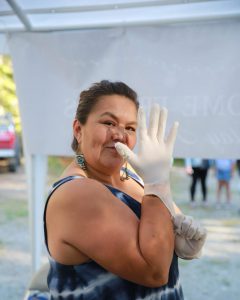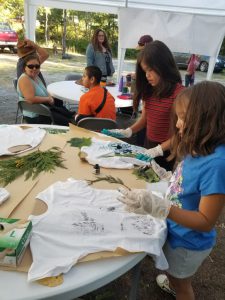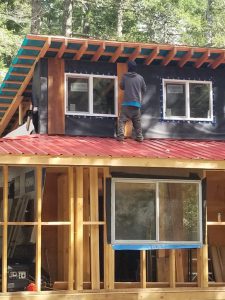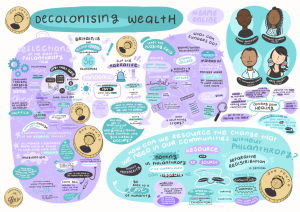MakeWay is so grateful to host and contribute to this bold, transformative, and joyful work! After a decade of baby steps towards correcting power in conventional philanthropy, the Right Relations Collaborative is a leap forward. Led by a council of Aunties – K’aayhlt’aa Haanas (Valine Brown), Nuskmata (Jacinda Mack), and Marilyn Baptiste; with co-leads Kim Hardy and ‘Cúagilákv (Jess H̓áust̓i), and supported by aligned funders like Sitka Foundation – the collaborative illuminates barriers within philanthropy and removes them, while joyfully supporting each other along the way.
“A lot of how we do the work in Nuxalk is very different from this capitalistic, desk-driven, boardroom-style way of doing business.” That’s Nuskmata (Jacinda Mack). As she says this, I sink into my office chair. It’s taken us three weeks to find a time to connect on the phone. Partly, she’s been out on the land: fishing, hunting, visiting with elders – “the real work,” she says. But partly it’s me: I’ve been desk-driven hard in my basement boardroom. “Like, that’s not how we do business,” she says.

Nuskmata is in her home village of Xats'ull, in what is colonially known as British Columbia. She’s Secwepemc and Nuxalk (Bella Coola), and as a community organizer and researcher, she spends her time going back and forth between the two villages. She’s the executive director of the Moccasin Footprint Society, an Indigenous charity that supports Indigenous knowledge, rights, and ways of life.
Nuskmata is also one-third of a council of three Aunties – along with K'aayhlt'aa Haanas (Valine Brown) and Marilyn Baptiste – that forms the governance backbone to the Right Relations Collaborative. Since 2020, the three Aunties and their two co-leads, 'Cúagilákv (Jess H̓áust̓i) and Kim Hardy, who leads Pacific partnerships at MakeWay, have brought together community-rooted Indigenous change-makers and aligned philanthropic partners to break down the institutional barriers that define conventional philanthropy and, at the same time, find new ways of being “in relationship” with one another.
Nuskmata is also one-third of a council of three Aunties – along with K'aayhlt'aa Haanas (Valine Brown) and Marilyn Baptiste – that forms the governance backbone to the Right Relations Collaborative. Since 2020, the three Aunties and their two co-leads, 'Cúagilákv (Jess H̓áust̓i) and Kim Hardy, who leads Pacific partnerships at MakeWay, have brought together community-rooted Indigenous change-makers and aligned philanthropic partners to break down the institutional barriers that define conventional philanthropy and, at the same time, find new ways of being “in relationship” with one another.

It’s a project that rests within the MakeWay Foundation platform, which both funds and functions as the administrative home for the collaborative. Any funder that wishes to offer money to the organization is vetted by the council of Aunties, demonstrating things like how their organization acquired its money, how their organization engages with the Truth and Reconciliation Calls to Action, how their organization supports the concepts of #LandBack and #CashBack, and so on. If accepted, the Aunties alone decide how and where the money is used, shifting power away from conventional philanthropic top-down models while addressing some of the deep-rooted inequalities of a colonial status quo.
I talked to members of the Right Relations Collaborative to find out more about how their funding model works, why it’s essential, and how they’re disrupting philanthropy as we know it.
The beginning
'Cúagilákv is a co-lead for the collaborative and a community organizer for the Heiltsuk community in Bella Bella. They’ve been fundraising for community-led non-profit work for the past 18 years. “And it’s by and large been a soul-crushing job,” they say. “Anyone who’s worked in fundraising understands just how intense and bureaucratic it can be.” 'Cúagilákv says they experience an additional layer of intensity: because they are part of the community they’re fundraising for, they understand with tangible clarity the urgency of their community’s needs. “It’s an immense amount of personal work, alongside the professional work,” they say, “and one that pushed me to burnout for years and years and years.”
'Cúagilákv would frequently have conversations with partners and other fundraisers experiencing similar problems, all asking, “Why are things the way that they are? And do they need to continue to be this way?” they say. Then, from the most unlikely of sources, some light shone through the murky depths of pandemic disturbance: umbrella charities, with support from the federal government, began deploying emergency funds to communities without the hurdles and barriers they’d usually face through lengthy, emotionally exhaustive application processes.
“I never in my wildest dreams imagined it would happen the way it did during COVID,” 'Cúagilákv says. “All of a sudden, we got to test all of these things that we’d been dreaming of.” Of course, COVID wasn’t always so generous: on the day I spoke with 'Cúagilákv, they were leading a youth camp in Bella Bella in the midst of a COVID outbreak. Throughout the interview, 'Cúagilákv received updates from colleagues who were testing hourly for the virus.
Removing those obstacles gave 'Cúagilákv proof of concept – that trust-based granting works. “And so, it just felt really silly and impossible to ever go back to doing things the way they were done before,” they say. “It felt like a really good moment to say, ‘How can we create our own structure that will entrench some of these new ways of doing things, and continue testing this model and hold it up as an alternative way to get resources to communities?’”
And with these thoughts and through conversations with trusted partners in the midst of a pandemic, the Right Relations Collaborative was born.
Bogged down in paperwork
'Cúagilákv started hearing the term “right relations” more often in the wake of the Truth and Reconciliation Commission, as an important overarching goal for settlers and Indigenous Peoples. “It felt right for me in the context of this work because it speaks to the kinship, reciprocity, and balanced power dynamics we’re trying to normalize through our work,” they say.
In conventional philanthropy, a grantee is often expected to provide extensive paperwork prior to, and throughout, their proposed project. “For a smaller organization with limited capacity, you have people who would normally be doing incredible program work, but who are so bogged down in the bureaucracy of fundraising, they can’t do their actual jobs,” 'Cúagilákv says.
This double-edged sword doesn’t benefit funders, let alone funding recipients, when the programming outcomes are being sacrificed at the expense of paperwork. Nuskmata agrees. She’s often applying for smaller grants in a competitive space. “And when you’re trying to find money to pay yourself, to then find more money … you end up in this poverty loop.”
In 'Cúagilákv’s experience, the interrogative nature of funding applications leads to feeling a need to “defend” a project’s worthiness. “We’re expected to perform or expose just incredibly personal information about the harms and trauma that people have endured to justify these grants being given to us,” they say. “That’s a challenge, when working in a community from a place of deep joy and love.” But as a fundraiser, they feel there’s an expectation to feel shame and perform poverty, “and trot out these traumas. It doesn’t feel good.”
Understanding the needs

For Nuskmata, the problem extends beyond the process of applying. She believes there is a lack of understanding around the needs of the people on the ground. “A lot of times, programs will be funded,” she says. “But if you don’t have the building to run that out of, you’re going to have a really hard time doing that work.” There is an assumption, she says, that applicants already have the basic shelter and tools to do the program they’re envisioning, but the reality for First Nations across Canada is that there is a huge shortage of housing.
According to Statistics Canada, more than one in five First Nations people lived in crowded housing in 2021. But to build on a First Nation reserve, permission is required from the federal government, as reserves are classified as federal land. “But if you’re building in your home village [not on a First Nation reserve], which I am, without the consent of the federal government, then it’s seen as illegal, even though we’ve never surrendered our lands,” says Nuskmata. “So if [anything] comes up that might be considered pushing the line on the Crown’s authority, the foundations tend to back off.”
She’s frequently told that what’s needed is Indigenous leadership. “It’s frustrating,” she says. “People are saying we need to know what the [Indigenous] systems are, we need all this stuff, but then they don’t want to support Indigenous Peoples to actually have the basic necessities to survive and live, never mind thrive.”
Participating in right relations
The “right relations” model is based on breaking down the colonial power structures that are systemic to Canadian society. That is to say, if you’re somebody with money ready to donate to the Right Relations Collaborative, you shouldn’t expect your contribution to be immediately accepted, if at all.
First, there is a vetting process carried out by the two co-leads, 'Cúagilákv and Kim Hardy. Through conversations with the funder, they identify whether the funder is ready to complete an “engagement framework” – a series of questions designed to measure new partners against a baseline ethical framework determined by the Aunties, to protect the reputation and integrity of the collaborative and its Indigenous members.
A key component to the framework asks funders to reveal their “money story.” That is, where did their wealth come from? “What I really love about this council is that we challenge those thoughts and assumptions,” says Nuskmata. “We ask very direct questions of the funders around their money story: How did they acquire that wealth? How are they in relationship with Indigenous Peoples? What are they doing to support Indigenous people through the Truth and Reconciliation Commission? How do they support UNDRIP [the UN Declaration on the Rights of Indigenous Peoples]? Are they aware of them? Do they understand them?” The list goes on. “That’s probably a real shock to funders,” says Nuskmata. “But we don’t want to be associated with [dirty money] because we hold ourselves to higher principles and values.”
If a funder’s money story and the broader engagement framework meet the basic eligibility requirements, it ends up with the Aunties, who, after assessing the funder’s values, make a final decision on whether to accept the money and begin a journey towards right relationship with the funder.
One funder who made it past the framework is Carolynn Beaty, executive director of the Sitka Foundation, a British Columbia–based private family foundation whose focus is to support biodiversity and the environment. Beaty says she didn’t feel judged when asked about her money story. “I have done a fair bit of personal work,” she says. “And our organization has done a fair bit of organizational work to be able to talk about these things in a vulnerable, open, and transparent way.”
The Sitka Foundation was founded by Beaty’s father, Ross Beaty, after a profitable career in mining. Although he’s mostly pivoted away from extraction to focus on renewable energy, he’s still involved as an investor and mentor, Beaty says. “The foundation didn’t have deep connections to begin with but is actively pursuing pathways to invest its capital in alignment with its mission.”
“One of the reasons I’m talking to you is to practise that openness and vulnerability,” Beaty says. “So it can be a point of discussion, and something to learn from.”
Hardy believes one of the real values of the Right Relations Collaborative is the learning experience of the funder. “First of all, exploring these questions they may have never reflected on before,” she says. “And there’s no skimping. Everybody’s in. And I think that’s when the funders crave the feedback.” Could this openness be what is needed to challenge long-held assumptions and begin a process of repair for Indigenous–settler relations? “I feel it’s the start of the power correction, and a new relationship,” says Hardy. “And I think that’s a really important and powerful thing.”
Since 2020, the Right Relations Collaborative has consented to relationships with seven funder partners, including the Sitka Foundation, Wilburforce Foundation, the Real Estate Foundation of BC, and MakeWay. The money enters a pooled fund and at the Aunties’ discretion is distributed to community partners when there is a need. “We have a still somewhat emergent but really solid and beautiful internal gift-making practice where we’re all hearing about one another’s needs and how we can resource them in a way that’s going to ensure everybody else can also have their needs met,” says 'Cúagilákv. “And the funders are not part of that conversation.”
The collaborative isn’t going to win hearts and minds universally. They’ve already heard feedback from funders who are “not ready” to engage yet. Despite this, Hardy believes the engagement framework is doing a lot of work just through existing. They’ve made it publicly available on the website and have received feedback from Indigenous organizations around the world, commenting on how powerful it is that the document exists as a point of reference when in conversation with funders. “That’s a big part of the reason why we are trying to be as transparent as possible about the process we use and the questions we ask,” 'Cúagilákv says. “I think there are tools we can share to empower other people to have better relationships with their vendors.”
They’ve already had to turn down potential funders that offered money without wanting to engage with the framework. “And I think it really speaks to the integrity of the whole thing,” says Hardy, who admits it felt difficult to shut the door on funds that could be spent on their members. For Nuskmata, it’s not about turning down the money, but about turning down the relationship. “It’s like any relationship. You have to ask, is there consent? Is there a willingness or desire to work together, or to be in relationship with each other?” she says. “It can’t be one-way; the power needs to be equal.”
And when she explains this, it seems so obvious that I wonder why society has fallen so far from such a human-centred notion. “When you come from a society that values money over people,” she reminds me, “it takes a real shift in perspective.”
Nuskmata explains that the value Indigenous Peoples bring to the table are those relationships and systems of governance that are based on equality and equity. “It’s based on the redistribution of wealth,” she says. “We have a very different perspective of what philanthropy actually is.” For Nuskmata, it’s more than just handing over a cheque. “It’s actually shifting the way that we think and work together and relate in the world.”
Respecting boundaries
'Cúagilákv and Hardy caution that there is also a level of gatekeeping that needs to happen with this shift toward right relationship. 'Cúagilákv says they are frequently expected to have conversations with funders that are nothing to do with the project they’ve received funding for. “There is this unspoken expectation that I owe them because they’re funding me,” they say. “I get tapped to do extra labour to help them understand Indigenous issues, relationships, protocols, and culture, and to be the person who can come and do their lunch-and-learns or proofread their blogs or help them understand all of these nuances that are escaping them.” This, unsurprisingly, is exhausting, 'Cúagilákv says.
It’s clear that funders are craving information and guidance from Indigenous Peoples, but this, say 'Cúagilákv and Hardy, needs to happen in a way that is respectful of the Aunties’ time, and the personal boundaries around their work. In their role as co-leads, 'Cúagilákv and Hardy act as human shields, ensuring that the Aunties are compensated for requests they agree to and that they have the opportunity to say no without feeling guilty because of complicated power dynamics.
What’s to come?

To 'Cúagilákv and Hardy’s surprise, when they first launched the engagement framework, funders seemed “profoundly relieved” to have difficult questions put before them. Although they recognize that, so far, they’re likely working with some of the more progressive funders. “What’s beautiful to me is that there are people who are ready to get vulnerable and ready to do this work and are coming to it with a really good heart,” says 'Cúagilákv. “And they’re actually not just invested in their own growth, but they’re really invested in the growth of their peers.”
The Right Relations Collaborative’s vision is impressive, particularly considering that the team has not once met in person. “There are a number of conversations waiting for a [physical] gathering because we really need to dig into that future building work,” says 'Cúagilákv. They say the collaborative would love to have more funders and Indigenous organizations join them, but only in a way that benefits both, “and not just by inviting anybody in for a boom-or-bust approach.”
Nuskmata has no doubt that in five years’ time, the collaborative’s philanthropic model will no longer be a new idea. “I think that it will be normalized within the philanthropy community,” she says. “And if [funders] are not engaging and shifting in these kinds of processes, they will be outdated.” Nuskmata believes the funders that are currently engaging with the collaborative are the thought leaders of today. “And I think that other organizations in the philanthropy world in general need to pay attention because we’re not going to go back.”
The name Nuskmata means “house or place of moose.” It’s thousands of years old, and in her name’s story, Nuskmata cleared the path for the “grease trails” – trade routes – between the coast and the interior. “And so – clearing the path is what guides my work,” she says.
